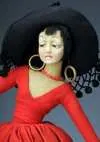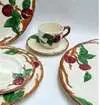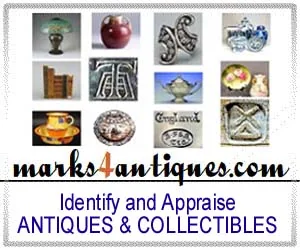Pricing Guides & Dictionary of Makers Marks for Antiques & Collectibles

EXAMPLES OF RESEARCH ANSWERS
TO PORCELAIN & POTTERY MARKS QUESTIONS
 As
most serious collectors and antiques dealers know, marks & backstamps on Porcelain,
Pottery or Chinaware, are almost never exactly as they are represented in reference books or
dictionary of marks guides. In real life, they come in all sorts of
variations or colors and are sometimes difficult to match or be certain when examining an item
to attribute it to a specific company or artisan. Also, makers’ marks
coupled with all kinds of additional symbols or notations, which may or may not mean anything,
complicates matters even further.
As
most serious collectors and antiques dealers know, marks & backstamps on Porcelain,
Pottery or Chinaware, are almost never exactly as they are represented in reference books or
dictionary of marks guides. In real life, they come in all sorts of
variations or colors and are sometimes difficult to match or be certain when examining an item
to attribute it to a specific company or artisan. Also, makers’ marks
coupled with all kinds of additional symbols or notations, which may or may not mean anything,
complicates matters even further.
But most importantly, nowadays there are so many fake and forged marks on recent reproductions that even years of experience can fool the best of us. At times, these are meant to deceive, as for example on some very recent Asian porcelain reproductions, but often are genuinely older marks that are very similar to even much older marks used by reputable companies. Although one can argue that these older imitation marks were also used to deceive their contemporary customers in thinking that their products are superior or at least as high in quality as those having a famous trademark of their times, these items are now considered to be actual antiques since they are often at least 100 years old. Common examples of these very old “copy” marks include many 19th or early 20thC variations of the Crossed Swords (Meissen), Crossed Ls (Sevres), Crowned N (Capo-di-Monte) and the “Beehive” (Royal Vienna) marks.
The point is that we all can have doubts and are frequently puzzled by marks we encounter in our research. If anything, this is a sign that you know enough to begin realizing that there is much more to learn – and if you are like us “antiques geeks” – this is usually where the fun begins.
However, beyond the pleasure from discovering new facts and trivia on a beloved collectible treasure or heirloom, there is also a distinct and nagging element of making certain that a mistake in identifying an item would not lead to a significant monetary loss. This is important for our business and it is also the ethical thing to do when we label our items and tell our customers of what we know on each piece. Accurate information on our items makes us expert collectors and successful dealers. Needless to say, the same reasoning applies when buying, since we want to make sure that we do not purchase items sold to us as antique, but instead are new imports.
It is worth noting that in spite of our great efforts in constantly updating our database with new findings and more variations of actual marks as observed on “real” items, we always encounter even more marks and unearth additional important facts during our continuing research.
For all these reasons and also because we want to ensure that our valued members can fully share in our ever-expanding knowledge and those of others that often contribute to our sites, we have committed to answer all questions from our members when in doubt or can’t find their marks in our database. This is what we mean by our HELP GUARANTEED, which is totally free of charge to our members.
Below are links to pages with a few examples of answers by our specialists that have been sent directly to our members around the world and that may also be of interest to others. As always, and true to our Privacy Policy, members’ personal information is not being shared with anyone and some of the answers have been edited or expanded in order to help in disseminating what is important without specific reference to the original member’s private question. Please enjoy…

IDENTIFY STAFFORDSHIRE IRONSTONE - GERMAN PORCELAIN FIGURINES - STUDIO POTTERY - ROYAL VIENNA PLATES - PORCELAIN FIGURINES
- Learn how to research & identify marks on STAFFORDSHIRE IRONSTONE PLATES - GERMAN PORCELAIN FIGURINES - STUDIO POTTERY - ROYAL VIENNA PORTRAIT PLATES - ARTS & CRAFTS AMERICAN STUDIO VASES and other collectible ceramics... READ MORE
IDENTIFY CROWN DEVON PORCELAIN BOX – CAPO-di-MONTE & PARIS PORCELAIN FIGURINES – LENCI PORCELAIN DOLL
- Learn how to research & identify marks on CROWN DEVON PORCELAIN BOX – CAPO-di-MONTE & PARIS PORCELAIN FIGURINES – LENCI PORCELAIN DOLL and other collectible ceramics... READ MORE
IDENTIFY ENGLISH STUDIO POTTERY - DEVON CHEESE DISH - LIMOGES PORCELAIN BOWL - DRESDEN BALLERINA FIGURINE
- Learn how to research & identify marks on ENGLISH STUDIO POTTERY– CHEESE DISH - LIMOGES PORCELAIN BOWLS & FLORAL PLATES - DRESDEN BALLERINA FIGURINES and other collectible ceramics... READ MORE
IDENTIFY GERMAN STUDIO POTTERY – STAFFORDSHIRE PITCHER - LENCI DANCER FIGURINE - NIPPON PLATE - MEISSEN PORCELAIN BOX
- Learn how to research & identify marks on GERMAN STUDIO POTTERY – STAFFORDSHIRE PITCHER - LENCI DANCER FIGURINE - NIPPON PLATE - MEISSEN PORCELAIN BOX - STAFFORDSHIRE FLOW-BLUE PLATTER - AUSTRIAN PORCELAIN FIGURINE - JAPANESE DISHES and other collectible ceramics... READ MORE
IDENTIFY SPONGEWARE BOWL - LIMOGES PLATES - GERMAN MUG or BEER STEIN - STAFFORDSHIRE TEAPOT
- Learn how to research & identify marks on SPONGEWARE BOWL - LIMOGES PLATES - GOUDA BOWL - GERMAN MUG or BEER STEIN - STAFFORDSHIRE TEAPOT - MASON'S IRONSTONE - BUTTER DISH - MINIATURE CUP & SAUCER and other collectible ceramics... READ MORE
IDENTIFY SEVRES STYLE PORCELAIN FIGURINE - MAJOLICA CLOCK - DELFT DESK SET - CHINTZ PLATE
- Learn how to research & identify marks on SEVRES STYLE PORCELAIN FIGURINE - PORCELAIN SHOE - MAJOLICA CLOCK - DELFT DESK SET - CHINTZ PLATE - 19thC STAFFORDSHIRE PLATTER and other collectible ceramics... READ MORE
IDENTIFY DRESDEN LACE FIGURINES - GERMAN PIANO BABY FIGURINE - FLOW-BLUE SET
- Research & identify marks on DRESDEN LACE FIGURINES - GERMAN PIANO BABY FIGURINE - INDIANA PATTERN PLATES - FLOW-BLUE SET - MINTON BOWLS - CHOCOLATE POT and other collectible ceramics... READ MORE
IDENTIFY LIMOGES VASE - DELFT PORCELAIN LAMP - FLORAL PORCELAIN BOX - BAUHAUS GERMAN POTTERY
- Research & identify marks on LIMOGES VASE - DELFT COBALT-BLUE PORCELAIN LAMP - FLORAL PORCELAIN BOX - PLLIVUYT & ALPICO OVENWARE - BAUHAUS GERMAN POTTERY - PORCELAIN VASE WITH SILVER OVERLAY and other collectible ceramics... READ MORE
IDENTIFY TALL BISQUE FIGURINES – FRANCISCAN-WARE - STAFFORDSHIRE DISHES
- Research & identify marks on TALL BISQUE FIGURINES – FRANCISCAN-WARE - STAFFORDSHIRE DISHES - STUDIO POTTERY - LIMOGES HAND-PLATED PLATE - PORCELAIN CAKE-STAND and other collectible ceramics... READ MORE
IDENTIFY MASON'S PATENT IRONSTONE – GERMAN PORCELAIN - HAND-PAINTED PLANTER - COBALT BLUE VASE WITH ENAMEL
- Research & identify marks on MASON'S PATENT IRONSTONE – GERMAN PORCELAIN - HAND-PAINTED JARDINIÈRE or PLANTER - STAFFORDSHIRE CHAMBER POT - COBALT BLUE VASE WITH ENAMEL - CERAMIC FLASK and other collectible ceramics... READ MORE
IDENTIFY ARMANI PORCELAIN FIGURINES – KUTANI FOO-DOG – ROYAL SATSUMA – PEDESTAL URN – ROYAL COPENHAGEN
- Research & identify marks on ARMANI PORCELAIN FIGURINES – KUTANI FOO-DOG – ROYAL SATSUMA – PEDESTAL URN – ROYAL COPENHAGEN – CHINESE PORCELAIN – PORCELAIN KITCHEN-WARE and other collectible ceramics... READ MORE

